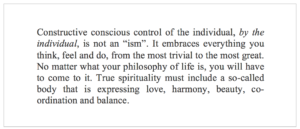This article was first published in "Going Mental" by Daniel McGowan.
The Suspension System of the Torso
The suspension system of the torso is of vital importance to our health, and the following analogy may help to make its function clearer. Imagine, a large round tent with the main support column or prop standing in the centre with the guy ropes spreading out from the top of it to keep the tent up. When the prop is at its full height, the guy ropes will have just the right amount of tension or tonus for maximum efficiency. If the prop is knocked too far into the ground, the guy ropes will go slack and the tent itself will become floppy. This is what happens to the muscles in the neck and torso when the spine shortens beneath its maximum height. When they are floppy, however, muscles cannot function efficiently and they will shorten themselves to regain maximum efficiency in this unbalanced and distorted situation. This shortening, this misuse, becomes firmly established as a huge habit. Some muscles become very tense, others very flaccid.
Some specific points about health are worth mentioning. The first result of pulling down and shortening is that we are not breathing efficiently. The rib-cage drops and the functioning of the muscles between the ribs is greatly impaired. The rib-cage becomes rigid and does not move freely in and out. Too much work is then thrown on to the diaphragm to keep us breathing. If the spine is restored to its optimal length, the rib-cage will regain its freedom of movement, because the first and the second rib will be suspended from the cervical spine in the neck, via the scalenus muscles and each successive rib will be suspended from the one above via the intercostal muscles.
If you consult a good anatomy book, you will see that the vocal apparatus is suspended from the mastoid processes of the head via the digastric and stylohyoid muscles as well as the hyoid bone, and yet the proper functioning of this little suspension system is vital to good singing.
Again, looking at an anatomy book, you will see that the thyroid gland is suspended, via the thyrohyoideus muscle, from the hyoid bone, which is suspended from the head as described above. We all know the importance of the thyroid gland in balancing the metabolic rate of the body, as well as its role in other vital functions like healthy growth in children. Some distressing effects like goiter can happen when its delicate hormonal balance is upset. But is it not feasible that the first reason for it going wrong is the collapse of the suspension system, which not only puts the thyroid gland under excessive pressure, but also distorts its shape?
The diaphragm and the heart are suspended from the head, neck, spine and sternum by an arrangement of connective tissue too complex to go into in this book. If the suspension system is not functioning, the heart will become distorted and be unable to beat with maximum efficiency. This will obviously cause damage to it, as well as sluggish circulation throughout the organism.
All the vital organs (viscera) in the abdominal cavity need room to function well and they rely on the spine to provide this space by being at its optimal length. When the spine shortens through misuse of the organism, the vital organs will come under great pressure and dis-ease and their efficiency will be impaired. They will slip down into the pelvis. Misuse is the main reason why this mistaken idea prevails that the pelvis is a basin for holding the abdominal contents and lower regions. This is not its function. It is there mainly for the attachment of the leg muscles, and we will consider this later.
I wish to give an example here, from my own teaching experience, of the vital importance of learning the conscious, co-ordinated use of the organism, which will allow the spine to function at its optimal length. Some years ago, a woman came to me suffering from a prolapsed uterus. The doctor told her she should have a hysterectomy, but she was terrified of having the operation. She was in a poorly co-ordinated state and her spine was shortened by 3-4 centimeters, causing her uterus to collapse.
I told her that as a teacher of constructive awareness, I could not promise her a cure, as curing people was not my business. I said I could teach her how to re-educate herself in the use of her organism, so that her spine could lengthen to its full height. If that happened then it seemed reasonable that the tissue connecting the spine would draw the latter back up again. She proved to be an excellent pupil, who learned quickly how to co-ordinate herself by thinking (not doing) her neck free, her head to go forward and up and her back to lengthen and widen. After 20 lessons the doctor told her that she did not need an operation.
It moves me greatly when a person, such as this woman, improves so much by learning how to become conscious of her misuse, and through the power of her thinking, improve not only her health, but also the quality of her life. Use of the self is the first thing we should consider when illness comes (and even before it comes). I feel deep sadness when I think of the people who have gone under the knife, when it may not have been necessary.
This article was first published in Going Mental by Daniel McGowan. You can download the PDF of this book for free here: FREE DOWNLOAD